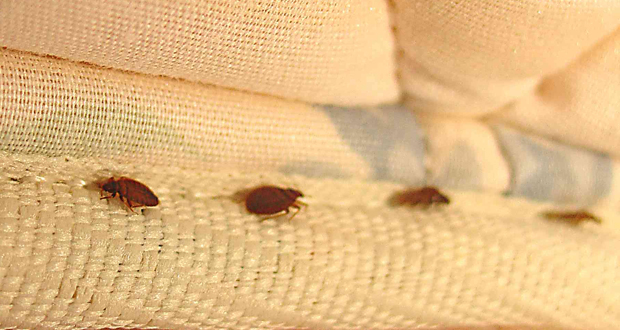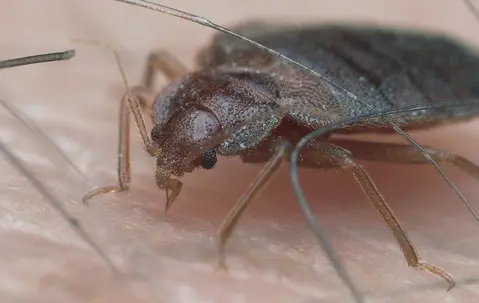Florida’s subtropical climate featuring mild winters, steady humidity, and warm conditions allows bed bugs to remain active and reproduce continuously. In Pensacola, a prominent Gulf Coast city in Florida’s Panhandle, these elusive insects often infiltrate homes, short-term rentals, or commercial buildings via luggage, secondhand furniture, or occupant belongings. By the time individuals spot dark specks on sheets or experience itchy bites, bed bugs may already be entrenched in mattress seams, upholstery folds, or along baseboard edges. This page highlights why bed bugs flourish in Florida, how to recognize them, and why reaching out to a professional bed bug exterminator is your most direct route to achieving a bite-free, peaceful living or working environment.
Whether you own a property in Pensacola or oversee rentals extending to Cantonment or Molino, recognizing bed bugs swiftly and choosing specialized, multi-phase treatments safeguards occupants from larger infestations, nighttime distress, and repeated do-it-yourself methods that often neglect concealed eggs or newly hatched nymphs lodged in tight cracks or crevices.
Why Bed Bugs Thrive in Florida
Mild Winter Temperatures
In colder parts of the country, subfreezing conditions severely reduce bed bug numbers, forcing them into dormancy for months. Florida’s gentle cold season rarely dips near freezing, letting bed bugs feed and lay eggs indoors all year. Climate-controlled interiors (roughly 65–85°F) further maintain every bed bug life stage egg, nymph, adult unless occupant or manager diligence interrupts them.
Frequent Movement of Items & People
Florida’s tourism, relocations, and secondhand furniture exchanges lead to frequent luggage or household item transfers ideal for bed bugs to hitchhike. In Pensacola, occupant turnover or short-term rental visitors may unknowingly transport bed bugs if occupant or manager inspections go overlooked. A single egg-laden piece of furniture or suitcase can seed a new infestation across multiple rooms.
Multiple Concealment Areas
Bed bugs flatten themselves to hide within mattress seams, box springs, upholstery folds, or behind baseboards emerging at night to feed on sleeping occupants. People usually notice them only after itchy bites or spotting blackish flecks on bed sheets, by which time bed bugs may occupy several corners or edges of a space.
Rapid Reproduction
A single female bed bug lays multiple eggs daily, each hatching within about two weeks under Florida’s mild winter climate. Nymphs mature in roughly one month, each producing yet more eggs if occupant or professional interventions fail. Ignoring a seemingly small cluster can quickly escalate into multi-room infiltration if occupant or manager detection comes too late.

Telltale Signs of a Bed Bug Infestation
- Nighttime Bites or Red Welts
- Usually on arms, legs, or neck areas uncovered while sleeping manifesting as small, itchy bumps in lines or clusters.
- Some individuals have intense bite responses (raised welts); others barely notice, slowing occupant detection.
- Usually on arms, legs, or neck areas uncovered while sleeping manifesting as small, itchy bumps in lines or clusters.
- Black Specks or Blood Stains on Linens
- Pepper-like black flecks (droppings) on sheets, pillows, or mattress seams.
- Rusty-colored smears occur if bed bugs are crushed after feeding.
- Pepper-like black flecks (droppings) on sheets, pillows, or mattress seams.
- Adult Bed Bugs
- Adults measure 5–7 mm, oval and apple-seed–shaped, flattening when not feeding, turning reddish-brown post-feeding.
- Nymphs are smaller, paler, and hide deeper in seams or cracks until feeding time.
- Adults measure 5–7 mm, oval and apple-seed–shaped, flattening when not feeding, turning reddish-brown post-feeding.
- Eggs & Shed Skins
- Pinhead-sized white eggs fixed to rough surfaces mattress edges, headboards, or baseboards.
- Translucent exoskeletons from molting nymphs confirm an ongoing bed bug cycle.
- Pinhead-sized white eggs fixed to rough surfaces mattress edges, headboards, or baseboards.
- Possible Musty Odor
- Larger infestations might produce a subtle, sweetish or musty smell from bed bug pheromones.
- More concrete indicators bites, excrement flecks, or occupant sightings remain more definitive than odor alone.
- Larger infestations might produce a subtle, sweetish or musty smell from bed bug pheromones.
- Occupant or Guest Complaints
- In multi-room or multi-unit dwellings apartments, short-term rentals occupants report repeated bites or bugs near beds.
- Swift occupant or manager action stops bed bugs from migrating to adjacent spaces or occupant belongings.
- In multi-room or multi-unit dwellings apartments, short-term rentals occupants report repeated bites or bugs near beds.
Why Neglecting Bed Bugs Is Harmful
Rapid Population Expansion
Each female bed bug lays numerous eggs daily. In Florida’s mild winters, eggs hatch 2 weeks later, and nymphs mature to lay more eggs in about a month. A minor infiltration soon covers multiple rooms or floors if occupant or professional responses lag, disrupting occupant tranquility.
Sleep Loss & Anxiety
Because bed bugs feed at night, occupant rest is disturbed. Continual bites provoke occupant insomnia or fear, scanning bedding for unseen feeders. Rental owners near Cantonment or Molino risk occupant annoyance or poor reviews if bed bugs hide undetected.
Spread to Nearby Spaces
In multi-room setups hotels, condos, or short-term rentals bed bugs traverse occupant luggage, baseboards, or hallway traffic. A bedroom outbreak quickly saturates entire buildings if occupant or manager checks remain inadequate.
Elevated Treatment Complexity & Costs
Small bed bug sightings managed early typically need only localized chemicals or partial steam usage. Delaying until bed bugs burrow behind walls or across multiple floors forces occupant relocations for entire-room heat or multiple chemical rounds, increasing occupant inconvenience and overall expenses.
Health & Image Concerns
Though bed bugs seldom transmit diseases, repeated bites lead to itching, possible infections from scratching, and occupant distress over invisible nighttime feeders. Lodging or property owners near Molino suffer occupant complaints or brand damage if bed bugs linger.

Why a Professional Bed Bug Exterminator Is Essential
Comprehensive Inspections
A bed bug exterminator investigates mattresses, furniture seams, baseboard edges, or behind décor for droppings, eggs, or adult bugs. Some rely on canines to detect concealed clusters. Precise infestation mapping ensures occupant synergy plus exterminator coverage from egg to adult.
Multi-Stage Extermination
Professionals often integrate vacuuming, steam, insecticidal applications, or entire-room heat treatments to kill bed bugs at every stage egg, nymph, adult. Single-step occupant tries (like random aerosols) generally kill visible adults but leave unhatched eggs or newly hatched nymphs hidden in deeper cracks.
Heat Treatments
For large or multi-room cases, raising interior temperatures above 120°F kills bed bugs (and eggs) in walls, electronics, or heavy upholstery. Occupants leave for several hours while exterminators confirm uniform heat distribution residue-free but comprehensive for thorough bed bug removal.
Chemical Sprays & Dust
Residual insecticides or dust along mattress edges, furniture folds, or baseboard cracks kill bed bugs crossing these areas after feeding. If occupant sightings persist, subsequent spot treatments or insect growth regulators target newly emerged nymphs. Experts apply chemicals carefully, limiting occupant or pet exposure.
Follow-Up & Occupant Guidance
Since eggs hatch 2 weeks post-laying, occupant or professional re-check ensures newly emerged nymphs also meet lethal measures. Occupants might enclose mattresses, launder items on hot cycles, or discard severely infested furniture finishing off bed bug breeding entirely.
Typical Methods for Bed Bug Treatments
- Inspection & Infestation Scale
- Exterminators check bedding, furniture folds, baseboards, or décor corners for droppings, eggs, or adult bugs.
- Identifying if bed bugs span one room or multiple floors shapes whether partial or entire-property coverage is imperative.
- Exterminators check bedding, furniture folds, baseboards, or décor corners for droppings, eggs, or adult bugs.
- Vacuuming & Steaming
- Vacuuming surfaces removes many visible adult bugs and eggs.
- Steam at 200°F kills bed bugs instantly in deeper mattress or furniture seams, chemical-free.
- Vacuuming surfaces removes many visible adult bugs and eggs.
- Chemical Insecticides
- Residual sprays or dust near bed frames, baseboards, or furniture seams hamper bed bug movement post-feeding.
- Insect growth regulators block nymph maturity, halting repeated egg cycles.
- Residual sprays or dust near bed frames, baseboards, or furniture seams hamper bed bug movement post-feeding.
- Heat Treatments
- Occupants vacate a few hours while specialists raise indoor temps to 120–135°F.
- Heat penetrates walls, electronics, or upholstery, killing bed bugs and eggs thoroughly no chemical residues.
- Occupants vacate a few hours while specialists raise indoor temps to 120–135°F.
- Mattress & Box Spring Encasements
- Zippered covers lock any bed bugs inside bedding materials, starving them if they can’t feed.
- Occupants regularly check these encasements for tears or fresh droppings indicating infiltration attempts.
- Zippered covers lock any bed bugs inside bedding materials, starving them if they can’t feed.
- Clutter Reduction & Hot Laundry
- Occupants wash sheets, curtains, or clothes on high-heat cycles, drying thoroughly to eliminate eggs or nymphs.
- Decreasing clutter removes potential re-grouping spots for bed bugs after occupant or pro treatments.
- Occupants wash sheets, curtains, or clothes on high-heat cycles, drying thoroughly to eliminate eggs or nymphs.
- Follow-Up & Re-Checks
- Eggs hatch 2 weeks after occupant sightings vanish. Scheduled occupant or manager visits confirm newly emerged nymphs also face lethal solutions.
- Additional occupant synergy or repeated chemical/steam usage cements occupant peace of mind.
- Eggs hatch 2 weeks after occupant sightings vanish. Scheduled occupant or manager visits confirm newly emerged nymphs also face lethal solutions.
- Inspection & Infestation Scale

Service Area: Pensacola, Cantonment, Molino
Bed bugs adapt readily throughout Florida’s mild winter environment, but this page specifically covers Pensacola plus Cantonment and Molino where occupant synergy and specialized bed bug treatments ensure thorough elimination. Florida’s gentle cold season rarely disrupts bed bug feeding or reproduction cycles, so occupant readiness and professional extermination remain crucial for fully eradicating them or blocking new infestations.
Why Choose Us
Florida-Oriented Strategies
We merge recognized bed bug tactics vacuuming, steam, insecticidal sprays, entire-room heat alongside occupant housekeeping suitable to Florida’s environment. Occupant synergy like discarding severely infested items or laundering on hot cycles teams with advanced extermination, surpassing occupant attempts that often miss concealed eggs or newly hatched nymphs.
Thorough Examinations
Before employing heat or chemicals, technicians carefully inspect bedding, furniture edges, baseboards, or behind décor for droppings, eggs, or adult sightings. Deciding if bed bugs affect only one bedroom or multiple floors clarifies partial vs. entire-property coverage needed for occupant well-being.
Safe, Targeted Treatments
Professionals apply insecticides or dust in precise bed bug hideouts, mattress edges, furniture folds, baseboards avoiding occupant floors or surfaces. For significant or multi-room problems, entire-room heat kills bed bugs behind walls or in electronics, leaving no chemical residue. Occupant synergy with decluttering or laundering finalizes the approach.
Follow-Up & Occupant Education
Because bed bug eggs hatch 2 weeks after being laid, occupant re-check or scheduled visits confirm newly emerged nymphs also meet lethal contact. Occupants may discard heavily infested furniture, encase mattresses, or wash bedding on hot cycles eradicating bed bug breeding thoroughly.
Quick, Local Assistance
Serving Pensacola plus Cantonment and Molino, we understand occupant turnover, short-term rentals, and Florida’s mild winter fueling bed bug expansions. Our proven methods and flexible scheduling limit occupant disruptions, ensuring bed bugs vanish across each life stage entirely.
Next Steps
Noticing small black specks on bedding, unexplained bites on exposed skin, or spotting apple seed–size bugs in furniture seams? Contact us to learn more or schedule your service. Our bed bug treatments for Pensacola and the surrounding locales of Cantonment, Molino unite thorough property inspections, multi-method extermination (steam, heat, insecticidal sprays), occupant housekeeping guidance, plus follow-up visits killing bed bugs at every stage while interrupting future egg cycles.
Act rapidly to protect occupants from ongoing bites, foil bed bugs burrowing behind walls, and evade occupant frustration from do-it-yourself solutions overlooking eggs or newly hatched nymphs. Count on our Florida-based bed bug exterminator proficiency to discover, remove, and deter these parasitic pests, giving occupants peace of mind despite Florida’s mild winter that otherwise fosters year-round bed bug feeding and reproduction.
